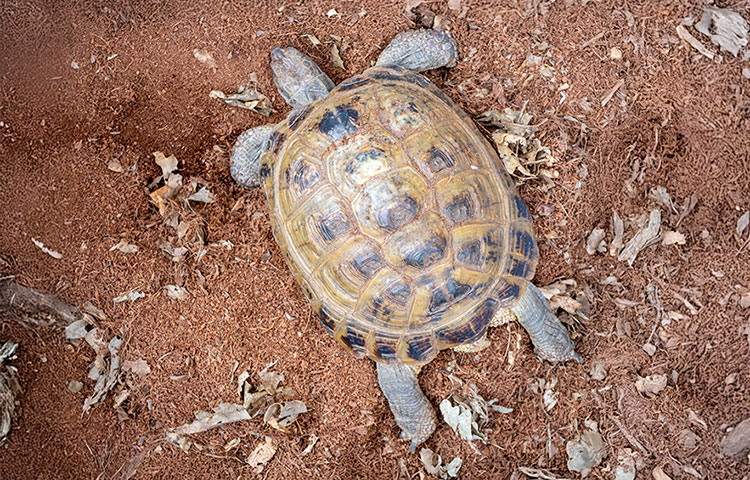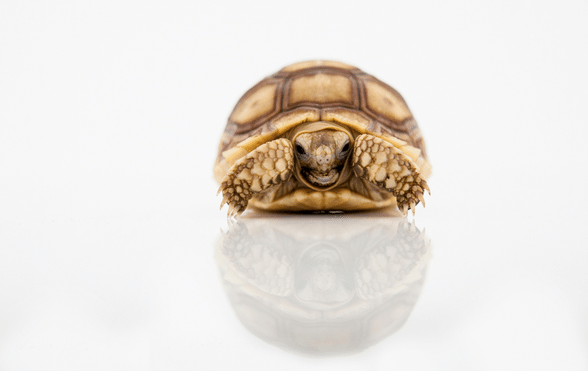Can you hibernate your tortoise? How and when should you hibernate your tortoise? We explain tortoise hibernation, different methods, and problems you should look out for.
process smoother and safe for your beloved pet. From knowing which species hibernate to setting up the right
environment and spotting any red flags, here’s how to support your tortoise through their winter rest.
Do tortoises hibernate?
Only certain species take that long winter nap. The ones that usually do include:
- Spur-Thighed Tortoise (Testudo graeca)
- Hermann’s Tortoise (Testudo hermanni)
- Horsfield’s/Russian Tortoise (Testudo horsfieldii or Agrionemys horsfieldii)
- Marginated Tortoise (Testudo marginata)
- Desert Tortoises (Gopherus agassizii)
If you’re unsure whether your tortoise should hibernate, consult your exotic pet vet.
When should you start preparing for tortoise hibernation?
By mid-August, it’s time to start getting your tortoise ready for hibernation. They should be in good shape and carrying enough fat reserves to see them through their winter sleep.
If the summer’s been cooler than usual and they start slowing down too early, keep them warm and bright to mimic sunnier climates.
If they’re still underweight by late September, skip hibernation this year and keep them active indoors instead.
And before you begin, a quick vet check can confirm they’re healthy and ready.

What is the fasting period?
Before hibernation, your tortoise will need to fast for 2–6 weeks, depending on their size. During this time:
- Stop feeding completely
- Bathe your tortoise daily in shallow warm water to keep them hydrated and help empty their digestive system
Your tortoise must be kept at 12°C for around 3 weeks after their last meal to allow full digestion. Undigested food can rot in the gut, leading to asphyxiation or infection.
How to weigh your tortoise
Weigh your tortoise regularly during preparation and hibernation. These ratios can help assess whether they’re a healthy weight:
- Jackson Ratio (Spur-Thighed and Hermann’s tortoises)
- McIntyre Ratio (Horsfield’s tortoises)
Only use each ratio for the correct species. If you’re unsure, consult your vet.

Hibernation methods
1. Fridge method
Yes, you can hibernate a tortoise in a dedicated fridge (not used for food).
You’ll need:
- A box slightly larger than your tortoise (plastic, cardboard or wood)
- Sterilised soil or substrate deep enough for burrowing
- Air holes for ventilation
Temperature control is vital.
- Ideal range: 4–5°C
- Acceptable range: 3–7°C
Avoid:
- Above 10°C: Your tortoise may wake up and burn through fat reserves
- Below 3°C: Risk of freezing
Tips:
- Keep the fridge in a room-temperature space (not a garage)
- Add sealed bottles of water to help stabilise internal temperature
- Open the fridge 3–4 times per week for fresh air
2. Box method (Outdoors)
You can also hibernate your tortoise in a shed or garage, using an insulated box.
You’ll need:
- Two boxes: A smaller one inside a larger one
- Inner box: Filled with a sand-soil mix
- Outer box: Filled with shredded paper for insulation
- A reliable thermometer to monitor temperature (3–7°C)
Make sure the space is dry, safe from other animals, and not subject to temperature swings. It’s also wise to consider security, as many tortoises have been known to go missing during outdoor hibernation.
What is the ideal temperature & humidity?
- 3–7°C is ideal for all hibernation methods
- Never below 3°C or above 10°C
- Maintain suitable humidity (Horsfield tortoises prefer it drier, while others may need more moisture. Use air holes to balance this.)
- Never below 3°C or above 10°C
- Maintain suitable humidity (Horsfield tortoises prefer it drier, while others may need more moisture. Use air holes to balance this.)
How long should tortoise hibernation last?
- 1 year old: 3 weeks
- 2 years old: 6 weeks
- 3 years old: 10 weeks
- Never exceed 12 weeks
Avoid hibernating tortoises under 1 year old. Younger tortoises are more at risk due to weight loss and vulnerability to illness.
Waking your tortoise up
Wake your tortoise gradually:
- Place the hibernation box in a warm room for an hour.
- Once moving, offer a warm shallow bath to help rehydrate.
- Ensure access to a basking lamp (26°C or more) and UV light to support vitamin D3 production and prevent metabolic bone disease.
They should be fully awake within a few hours. After hibernation, your tortoise will need time to warm up and regain energy. Gradually reintroduce food and keep an eye out for signs of illness. You can read more about post-hibernation tortoise care here.
What to expect after hibernation
If your tortoise doesn’t eat after 14 days, see a vet. It could be:
- Inadequate temperature
- Overlong hibernation
- Illness (e.g. mouth rot)
Other post-hibernation ailments include:
- Cloudy eyes or blindness
- Frostbite
- Swellings
- Green urine
- Lethargy and weight loss
Weight loss during hibernation
Tortoises can safely lose up to 1% of their body weight per month. If they lose more, wake them up and do not resume hibernation. You need to weigh your tortoise:
- After fasting (pre-hibernation)
- Weekly during hibernation
If your tortoise wakes early
Do not try to re-hibernate. Waking means their metabolic system has restarted.
The most likely reason is that the temperature has been too warm (over 10°C). If they wake up, simply repeat the same gentle rehydration and warming steps you used before.
Pooping, peeing, or scratching during hibernation
- Pooping is usually okay as long as it isn’t diarrhoea.
- Urinating means your tortoise is dehydrated so wake them up immediately.
- Scratching suggests they’ve woken up so check your temperature settings.
Do tortoises need to hibernate?
There’s debate among experts. Hibernation may:
- Rest the reproductive organs (some say it boosts fertility)
- Help prevent certain health issues
If you choose not to hibernate your tortoise:
- You’ll need to provide heat, light, and UV throughout winter (overwintering)
- Make sure they get enough rest and remain healthy
Protection beyond hibernation
With the right preparation, hibernation can be a safe and healthy part of your tortoise’s life. And while you can’t
protect them from every bump in the road, having the right pet insurance means you’re ready for the unexpected…

